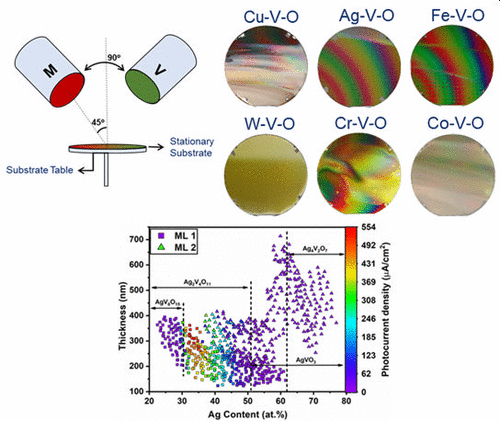当前位置:
X-MOL 学术
›
ACS Comb. Sci.
›
论文详情
Our official English website, www.x-mol.net, welcomes your feedback! (Note: you will need to create a separate account there.)
High-Throughput Exploration of Metal Vanadate Thin-Film Systems (M–V–O, M = Cu, Ag, W, Cr, Co, Fe) for Solar Water Splitting: Composition, Structure, Stability, and Photoelectrochemical Properties
ACS Combinatorial Science ( IF 3.903 ) Pub Date : 2020-10-26 , DOI: 10.1021/acscombsci.0c00150 Swati Kumari 1 , João R C Junqueira 2 , Wolfgang Schuhmann 2 , Alfred Ludwig 1
ACS Combinatorial Science ( IF 3.903 ) Pub Date : 2020-10-26 , DOI: 10.1021/acscombsci.0c00150 Swati Kumari 1 , João R C Junqueira 2 , Wolfgang Schuhmann 2 , Alfred Ludwig 1
Affiliation

|
Combinatorial synthesis and high-throughput characterization of thin-film materials libraries enable to efficiently identify both photoelectrochemically active and inactive, as well as stable and instable systems for solar water splitting. This is shown on six ternary metal vanadate (M–V–O, M = Cu, Ag, W, Cr, Co, Fe) thin-film materials libraries, fabricated using combinatorial reactive magnetron cosputtering with subsequent annealing in air. By means of high-throughput characterization of these libraries correlations between composition, crystal structure, photocurrent density, and stability of the M–V–O systems in different electrolytes such as acidic, neutral and alkaline media were identified. The systems Cu–V–O and Ag–V–O are stable in alkaline electrolyte and exhibited photocurrents of 170 and 554 μA/cm2, respectively, whereas the systems W–V–O, Cr–V–O, and Co–V–O are not stable in alkaline electrolyte. However, the Cr–V–O and Co–V–O systems showed an enlarged photoactive region in acidic electrolyte, albeit with very low photocurrents (<10 μA/cm2). Complete data sets obtained from these different screening sets, including information on nonpromising systems, lays groundwork for their use to predict new systems for solar water splitting, for example, by machine learning.
中文翻译:

用于太阳能水分解的金属钒酸盐薄膜系统(M-V-O、M = Cu、Ag、W、Cr、Co、Fe)的高通量探索:组成、结构、稳定性和光电化学性能
薄膜材料库的组合合成和高通量表征能够有效地识别光电化学活性和非活性,以及稳定和不稳定的太阳能分解系统。这在六种三元金属钒酸盐(M-V-O,M = Cu,Ag,W,Cr,Co,Fe)薄膜材料库上显示,使用组合反应磁控管共溅射制造,随后在空气中退火。通过对这些库的高通量表征,确定了 M-V-O 系统在不同电解质(如酸性、中性和碱性介质)中的组成、晶体结构、光电流密度和稳定性之间的相关性。Cu-V-O 和 Ag-V-O 体系在碱性电解质中稳定,光电流分别为 170 和 554 μA/cm 2,而 W-V-O、Cr-V-O 和 Co-V-O 系统在碱性电解质中不稳定。然而,Cr-V-O 和 Co-V-O 系统在酸性电解质中显示出扩大的光活性区域,尽管光电流非常低(<10 μA/cm 2)。从这些不同的筛选集获得的完整数据集,包括关于无前景系统的信息,为它们用于预测太阳能水分解的新系统奠定了基础,例如,通过机器学习。
更新日期:2020-12-14
中文翻译:

用于太阳能水分解的金属钒酸盐薄膜系统(M-V-O、M = Cu、Ag、W、Cr、Co、Fe)的高通量探索:组成、结构、稳定性和光电化学性能
薄膜材料库的组合合成和高通量表征能够有效地识别光电化学活性和非活性,以及稳定和不稳定的太阳能分解系统。这在六种三元金属钒酸盐(M-V-O,M = Cu,Ag,W,Cr,Co,Fe)薄膜材料库上显示,使用组合反应磁控管共溅射制造,随后在空气中退火。通过对这些库的高通量表征,确定了 M-V-O 系统在不同电解质(如酸性、中性和碱性介质)中的组成、晶体结构、光电流密度和稳定性之间的相关性。Cu-V-O 和 Ag-V-O 体系在碱性电解质中稳定,光电流分别为 170 和 554 μA/cm 2,而 W-V-O、Cr-V-O 和 Co-V-O 系统在碱性电解质中不稳定。然而,Cr-V-O 和 Co-V-O 系统在酸性电解质中显示出扩大的光活性区域,尽管光电流非常低(<10 μA/cm 2)。从这些不同的筛选集获得的完整数据集,包括关于无前景系统的信息,为它们用于预测太阳能水分解的新系统奠定了基础,例如,通过机器学习。



























 京公网安备 11010802027423号
京公网安备 11010802027423号